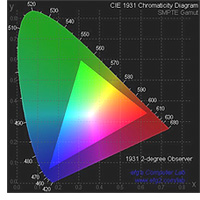 By Andrew Liszewski
By Andrew Liszewski
As much as you may love that new LCD screen of yours it’s just not able to display the full range of colors your eye is capable of detecting. Sure that 8-bit graphics card is partly to blame (and even that 10-bit capable card you splurged on is still not enough) but the other issue is that you can only produce so many colors by mixing red, green and blue which is how all displays work. (That triangle region in the image to the right shows the RGB Gamut which is what a display can reproduce compared to the full color spectrum.)
Researchers now believe they can create a display capable of showing the full range of colors the human eye can perceive. Using diffraction gratings which are basically a pattern of very thin, equally spaced grooves on a surface they can cause white light to fan out into the full color spectrum. (The same thing happens on a CD where the pits and grooves of the recording produce a rainbow effect under direct light.)
The fanned out color spectrum could then be specifically angled by using an aritificial muscle membrane to dynamically adjust the spacing between the grooves on the diffraction grating. Being able to angle the spectrum then allows the desired color to be aimed at a screen where it would be isolated and then displayed as a color pixel.
Right now the technology is only in the proof of concept stage but the researchers believe with enough investment it could be seen in consumer products in less than eight years.










